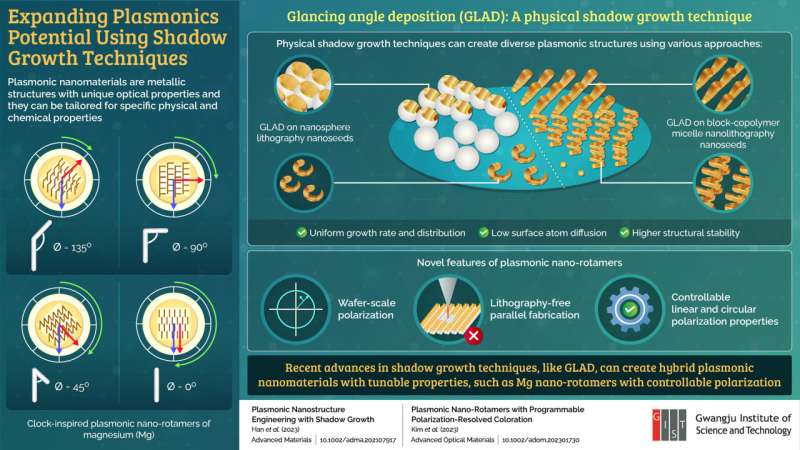This article has been reviewed according to Science X's editorial process and policies. Editors have highlighted the following attributes while ensuring the content's credibility:
fact-checked
peer-reviewed publication
trusted source
proofread
Researchers showcase new breakthroughs for unlocking the potential of plasmonics

Plasmonics are special optical phenomena that are understood as interactions between light and matter and possess diverse shapes, material compositions, and symmetry-related behavior. The design of such plasmonic structures at the nanoscale level can pave the way for optical materials that respond to the orientation of light (polarization), which is not easily achievable in bulk size and existing materials.
In this regard, "shadow growth" is a technique that utilizes vacuum deposition to produce nanoparticles from a wide range of 2D and 3D shapes at nanoscale. Recent research progress in controlling this shadow effect has broadened the possibilities for the creation of different nanostructures.
Now, in twin studies led by Assistant Professor Hyeon-Ho Jeong from the Gwangju Institute of Science and Technology (GIST), Republic of Korea, researchers have comprehensively shed light on the recent advances in shadow growth techniques for hybrid plasmonic nanomaterials, including clock-inspired designs containing magnesium (Mg).
The studies were published in Advanced Materials on 25 March 2022 (with Jang-Hwan Han and Doeun Kim as co-first authors and Professor Peer Fischer and Dr. Jeong as co-corresponding authors) and Advanced Optical Materials on 20 November 2023 (with Juhwan Kim and Jang-Hwan Han as co-first authors and Dr. Jeong as the corresponding author), respectively.
The shadow effect here refers to the presence of "dark" areas on a surface that are concealed by "seed" molecules, and hence, inaccessible for the deposition of vaporized materials, much like shadow areas where light cannot reach.
Elaborating on this further, Dr. Jeong says, "Since these shadowed areas are the regions where the material cannot be deposited, an array of three-dimensional nanostructures can be formed. This formation depends on the size of the seed, spacing between the seeds, and the inclination of the substrate."
In addition, says Doeun Kim, a Ph.D. student, "Creation of unique nanostructures is influenced by the introduction of rotation during the process, based on rotation speed, time, and angle, ultimately forming three-dimensional nanostructures."
In the first study (featured as a cover-page article), the team showcased the production of various nanostructures using a specific shadow growth technique known as glancing angle deposition. These structures exhibit tunable optical properties achieved through suitable modifications to their material, shape, and surrounding environment.
Their review also emphasizes a broad range of potential applications, including nano- and micro-robots for wound healing and drug delivery in the human body, photonic devices, and chiral spectroscopy, among others.
For the subsequent study, the team created 3D rotamers (molecules with specific rotational arrangements) capable of both linear and circular polarization, as well as storing a significant amount of information.
This clock-inspired design involves placing two nanorods made of Mg at a certain modifiable angle, resembling the hour and minute hands of a clock. These nanostructures also hold promise for various applications, such as the secure verification of items like banknotes, anti-counterfeiting devices, and displays capable of transitioning to desired optical states, as needed.
Talking about these developments and envisioning the future of plasmonics, Dr. Jeong says, "These rotamers can have potential utilization in physically unclonable functions, an area currently under intensive research for ensuring robust security levels of hardware, such as PCs or servers."
Ph.D. student Juhwan Kim adds, "In particular, the ability to selectively filter UV light sources and specific visible wavelengths depending on the polarization state can also be used in glasses and windows to protect eyes and skin by blocking UV rays from sunlight."
More information: Jang‐Hwan Han et al, Plasmonic Nanostructure Engineering with Shadow Growth, Advanced Materials (2022). DOI: 10.1002/adma.202107917
Juhwan Kim et al, Plasmonic Nano‐Rotamers with Programmable Polarization‐Resolved Coloration, Advanced Optical Materials (2023). DOI: 10.1002/adom.202301730
Journal information: Advanced Materials , Advanced Optical Materials
Provided by Gwangju Institute of Science and Technology





















